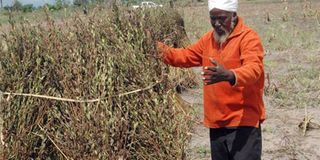With simsim, erratic rains don’t worry me

Mr David Ndirangu at his farm in Mpeketoni, Lamu County with his harvest. PHOTO | LABAN WALLOGA
What you need to know:
- Quest to avoid loss pushes Ndirangu into simsim farming, now he makes Sh25,650 in a season
Sometime back, Mr David Ndirangu planted several crops, including maize, which performed poorly because the rains disappeared.
Ndirangu incurred huge losses as he did not harvest anything despite investing huge sums of money in the business.
Eager to avoid losses and have something to cultivate during the short rains seasons, the farmer asked an agricultural extension officer what crops he can plant to triumph over erratic rains and the warm weather in Lamu, where he lives.
The officer told him to try sesame (simsim). “I learned that sesame performed well in little rains and does not require fertiliser. This made me plant it,” he recounts.
It is now over five years since the farmer started growing sesame and he has not turned back.
“I mainly grow sesame during the short rains season since the crop takes only three months to mature. While other farmers plant maize, watermelons and beans, which fail because rains disappear, I concentrate on sesame,” he tells Seeds of Gold.
However, he sometimes intercrops sesame with watermelons and maize during the long rains season.
Sesame, a seed oil crop that is high in protein is used in bakeries and to make oil. The seeds can also be eaten at home after roasting.
“Sesame produces about 50 per cent of edible oil products. It is also used in making margarine, soap and in the perfume industry as a fixative,” explains Ndirangu, who has a three-acre farm.
Those are not the only benefits. Sesame is a protein supplement in livestock and poultry feeds.
Some farmers, particularly in Coast region, prefer to intercrop it with maize and cassava. However, sesame should preferably be grown alone.
“While still young, simsim is very sensitive to weeds. After germination, weeding must be done in two weeks. Second weeding should follow immediately after thinning depending on the weeds type,” he says.
Simsim growing, according to the farmer, has minimal losses.
“It is a profitable crop because it does well when there is shortage of rain. When sesame germinates, the probability of failure, especially when rains disappear is minimal,” he says.
Harvesting is done before sesame capsules start shattering.
To harvest, one cuts the crops at the base or up roots and ties them in bundles for drying on a rack.
The bundles are put on the drying rack with capsule tips facing upwards or in a slanting manner to avoid seed loss.
Once dry, the bundles are hit gently to release the seeds. The seeds are then dried.
In a good season, Ndirangu harvests about 270kg of sesame per acre, which earns him Sh25,650. This, according to him, however, is below the expected output.
Simsim has potential yields of between 500 to 1,000kg an acre.
Each kilogramme fetches Sh95 in the market. However, according to him, brokers exploit the farmers.
“Brokers are shrewd, they come to buy our produce from our homes. If we had an association or a cooperative society, we would beat them since the organisation would help us market our produce,” he says.
Mtwapa Kenya Agricultural Research Institute (Kari) plant breeder Stephen Weru says the white sesame variety is popular for confectionary while the black one is preferred for its high oil content.
Weru says if pests and diseases are controlled on the farm, sesame production per hectare is about 700kg.
Fifteen years ago, sesame was a popular cash crop in Coast region since there was ready market at Ufuta Company in Changamwe.
“The influx of cheap edible oil imports affected its growing. Many farmers abandoned it. That is why those who are growing it have not stopped planting maize.”
TO GET BETTER YIELDS
One should plant a recommended sesame variety for a particular region.
Farmers are advised to plant at the onset of short rains. When plants are about 10cm high, thinning is done to leave five plants a hole.
Weeding is done two weeks after germination. Second weeding comes after thinning.
The crop does not require fertiliser since it survives in soils that are not fertile. To get better yields, the crop requires spraying against pests and diseases.
During harvesting, the crop is uprooted or the stem is cut at its base to prevent capsules from shattering. Then the stems are tied into bundles for drying.





